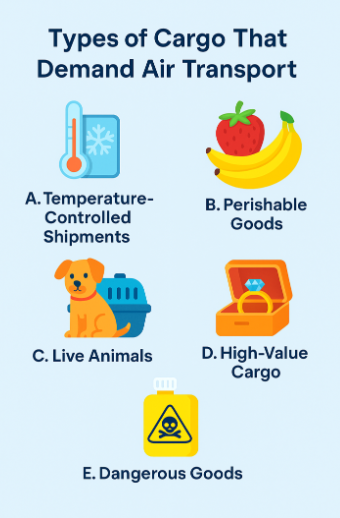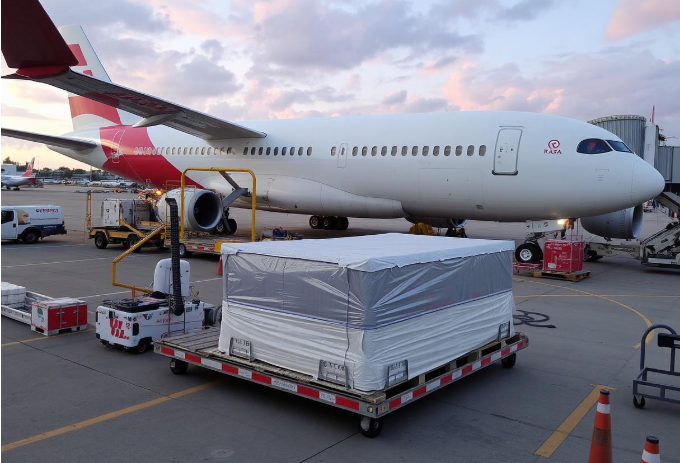Air cargo handles over $8 trillion worth of goods annually, accounting for roughly 33% of global trade by value.When speed is mission-critical, traditional shipping methods simply can’t keep up. Even though air freight can cost 400% to 700% more per pound than ocean transport, demand continues to rise, driven by globalized supply chains and the need for fast, reliable delivery. The market is projected to surpass $210 billion by 2027.
With the ability to move goods anywhere in the world within 24 hours of arrival at an airport, air cargo plays a vital role in transporting time-sensitive shipments. Its strategic importance became even more evident during the COVID-19 pandemic, when it generated one-third of airlines’ total revenue. A recent 11.4% year-over-year increase in demand reflects just how essential air freight has become in solving high-stakes logistical challenges.
In this article, we’ll examine the real-world scenarios where air cargo isn’t just an alternative, but the only viable choice. You’ll explore examples of urgent delivery situations, learn which types of goods rely on air transport, and gain a practical framework to assess when this premium shipping method is worth the investment.
When Speed Is Non-Negotiable: Urgent Delivery Scenarios
In life-or-death situations or high-stakes operations, shipping speed is not optional. Air cargo becomes the only viable choice across several mission-critical scenarios where delays are simply unacceptable.
1. Medical and Emergency Response
Medical emergencies demand immediate logistics. In the U.S. alone, hospitals handle over 130 million emergency room visits annually, requiring rapid access to life-saving equipment and supplies.
Organizations like Boston MedFlight transport over 6,100 critically ill patients per year, including 1,545 pediatric and neonatal cases.These services often provide over $7 million in free care annually to patients with little or no insurance.
Time-sensitive medical shipments (e.g., organs, blood, antivenoms) regularly rely on air transport to reach hospitals in time.
2. Humanitarian and Disaster Relief
In natural disasters or armed conflict zones, air cargo serves as the first responder in logistics.
- The United Nations Humanitarian Air Service (UNHAS) moves over 388,000 passengers and 4,800 metric tons of cargo annually to more than 400 remote destinations.
- In 2021, Airlink shipped over 5 million units of PPE to support global health crises.
Speed and access to remote or blocked regions make air cargo indispensable for humanitarian relief.
3. Just-in-Time Manufacturing
Delays in global supply chains can bring production lines to a standstill, especially in automotive and electronics manufacturing.
- For car manufacturers, a one-hour shutdown can cost thousands of dollars.
- In one real case, microchips were shipped overnight from Singapore to Mexico to prevent a costly halt in operations.
Despite high costs, air freight often proves financially justifiable compared to the cost of downtime.
4. Pharmaceutical Logistics
Air cargo plays a vital role in transporting temperature-sensitive pharmaceuticals, such as vaccines, biologics, and blood products.These account for about 4% of all global air cargo tonnage.
Maintaining strict temperature control is crucial to preserve efficacy and safety. Shipments typically follow Good Distribution Practices (GDP) and require rapid, secure movement, only possible by air.
5. High-Tech and Critical Components
After the COVID-19 pandemic disrupted supply chains, many manufacturers turned to air charter services to secure access to essential partslikesemiconductorsand microchips.
These components are vital for industries such as electric vehicle production, where delays can impact entire product lines.
Timely air cargo deliveries allowed companies to maintain operational continuity during unpredictable global shortages.
Types of Cargo That Demand Air Transport
Certain commodities simply cannot withstand the long transit times associated with ocean or ground transport. For products where value, urgency, or special handling are key factors, air cargo provides the only practical solution.

A. Temperature-Controlled Shipments
Temperature-sensitive goods make up a significant portion of air cargo logistics, particularly in the pharmaceutical and healthcare sectors. These products must maintain specific temperature ranges throughout the journey. The industry classifies these shipments into standard categories:
- Frozen: –10°C to –25°C
- Cold: 2°C to 8°C
- Controlled Room Temperature: 15°C to 25°C
- Deep Frozen: –150°C to –195°C
Even minor temperature fluctuations can compromise product integrity, making specialized air transport essential.
B. Perishable Goods
Perishables are another critical category. Items such as fresh fruit, exotic vegetables, seafood, and cut flowers rely on air freight to preserve quality and extend shelf life. These products require short transit times and stable environments to avoid spoilage. According to IATA, about 20% of fruits and vegetables are lost after harvest due to inadequate transport conditions.
C. Live Animals
Transporting live animals—whether pets, racehorses, zoo animals, or endangered species—requires careful planning and humane treatment. Air transport is considered the most reliable and humane method for long-distance animal relocation. The industry follows IATA’s Live Animals Regulations (LAR), which set global standards for animal welfare during air travel.
D. High-Value Cargo
Luxury goods, fine art, precious stones, and high-end electronics fall under the high-value category. These shipments demand enhanced security, minimal handling, and fast delivery. Air transport offers built-in advantages such as GPS tracking, secure storage, and specialized handling protocols that reduce exposure to theft or damage.
F. Dangerous Goods
Dangerous goods represent a complex category governed by strict international regulations. Classified into nine hazard classes—ranging from explosives to flammable liquids and radioactive materials—these items require:
- Approved packaging
- Detailed documentation
- Specialized handling and staff training
Roughly 1.25 million dangerous goods shipments are transported by air each year, all subject to rigorous safety standards.
Conclusion
Air cargo remains the only viable choice when speed, reliability, and specialized handling are non-negotiable. Whether it’s life-saving medical supplies, perishable goods, or high-value components, certain shipments simply cannot afford the delays of traditional transport methods. While the cost of air freight is significantly higher, in time-critical scenarios, it becomes a strategic investment, ensuring business continuity, protecting sensitive cargo, and meeting urgent customer demands.


